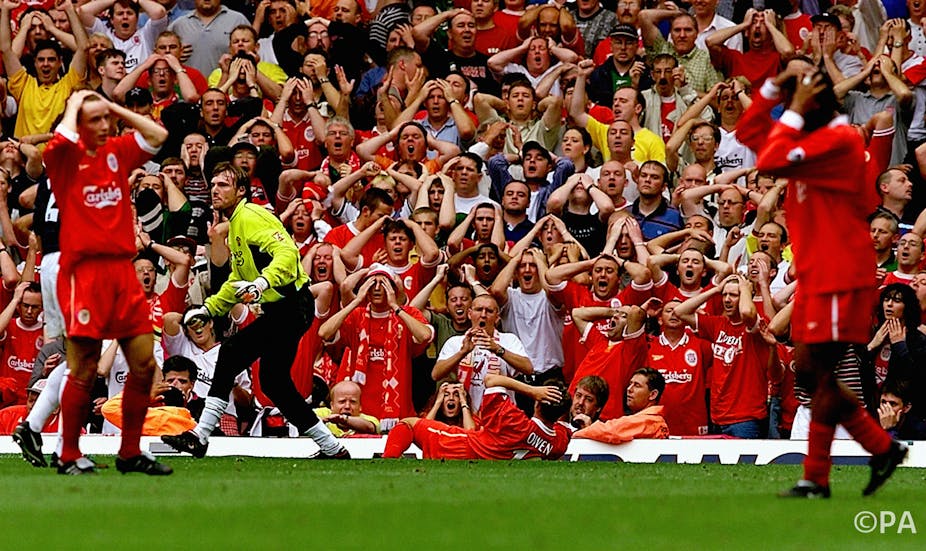Football fans attending matches at the Euro 2016 tournament in France will be hoping for plenty of good reasons to cheer, chant and comment about what unfolds on the pitch. But throughout the emotional ebb and flow of each of the 51 games, another story will be written in the faces and actions of the spectators and players. Non-verbal communication, or body language, tells their story without words.
Since the time of our earliest ancestors, body language kept us alive by communicating our needs to others. With a frightened facial expression or a pointing hand gesture we connected with each other, revealing our inner thoughts and feelings. It is not that surprising then, to see this biological heritage on display in everyday life - especially in matters as important as football. So what do we do and why do we do it?
Head in hands moments
The head-clasp and the head-cradle are subconscious gestures often made by sports fans in tense moments. When a player shoots for goal but narrowly misses, thousands of supporters instinctively and in unison cover the tops of their heads with their hands like a shield. The fans are forming a shield which protects against a psychological - rather than physical - blow in the instant of a devastating missed opportunity.

In the head cradle, the hands perform a supportive and comforting role behind the back of the head. Placing one’s hands around the back of one’s head repeats the comfort a mother offers a baby to support her head. You can often spot the cradle when a team has just been relegated. Silent and inconsolable, the desolate fan stands holding the back of their heads as they attempt to deal with the disappointment.
Football stands
Although we are fully aware of specific parts of our body, we are least aware of the movement of our legs and feet. Our legs are associated with the primitive impulses of flight. It’s common to see people instinctively sit down after hearing some bad news. On hearing good news, however, people often jump to their feet instead. In the animal kingdom, the alphas show their status through posture. They demonstrate their height, stick out their chests, and take up as much space as possible to show their powerful presence. Holding these powerful poses can also make you more powerful. Goals, especially in tight games, bring the fans to their feet to display their pleasure and status.

Shirts off
Players ripping their shirts off after scoring an important goal is a common scene, though forbidden by the rules. It is a reaction which reflects a biological imperative to display dominance over one’s opponents. Such victory gestures are a natural need and establish order and hierarchy in society.
Researchers observed winners of Olympic and Paralympic judo matches and their triumphant gestures. These displays included raising their arms above the shoulders, pushing the chest out, and tilting the head back and smiling. Blind Paralympic athletes also displayed these actions suggesting the biological instinct. This biological instinct might also explain why Aberdeen’s Barry Nicholson, following his 89th minute equaliser against Hearts at Tynecastle in 2007, took his shirt off instinctively and then realised what he had done. He tried in vain to get his shirt back on but his teammates were too busy congratulating him to care.
Sing when you’re watching
But at football matches, as a soundtrack to all the subliminal messages of body language, verbal communication always fills the air. Chanting is part of the furniture of football, and ranges from clever and funny to vile and offensive. Some songs support your team and some intend to hurt the opposition. But most importantly the songs are sung together, displaying a shared social identity. Singing in the stands means interpersonal connection with a shared purpose beyond any one individual. It harbours emotion and evokes memories. It is delivered in unison and its quality rarely judged.
The unity and identity shared among football fans from the shirts, scarves and hats they wear is clear. But if we look more closely, we can also see a story that began millions of years ago with the earliest humans that tells us about our evolution. It is most clear during moments such as vital penalties taken in the knock-out stages, when thousands of hands clasp thousands of heads.

